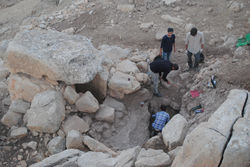Jebel al-Mutawwaq
 |  |  |  |  |
|---|---|---|---|---|
 |
Season 2023
Excavation results of the Spanish-Italian expeditions
Area C-EST
Area CEst, under investigation since 2014, is a large open excavation focused on exploring the Great Enclosure, a significant monument of the Early Bronze Age I city of Jebel al-Mutawwaq. The Great Enclosure is an open-air semicircular sanctuary with a diameter of approximately 60 meters. It features a central standing stone, a nearly perfectly preserved door on the western side, and a surrounding wall that reaches a height of 1.5 meters in its northern section. The enclosure has been confirmed as a sacred space, used not only for community gatherings and public economic activities but also for ritual purposes.
In the 2023 season, excavations focused on the external side of the Great Enclosure, where a trench measuring 13 x 2.5 meters was opened.
During this excavation, a small wall (W.1603) was uncovered. It consists of two rows of small stones, measures 1.5 meters in length and 0.5 meters in width, and runs north-south. The wall is built against the Great Enclosure and terminates with a large angular stone, which was not fully excavated as it extends beneath the northern section of the trench. The function of this wall remains unidentified. In the final layer covering the bedrock on both the eastern and western sides of W.1603, several fragments of mud bricks were discovered. These bricks, reddish in color and containing vegetal and mineral inclusions, represent the first evidence of mud-brick use at Jebel al-Mutawwaq. However, the poor preservation of the bricks and their limited distribution within the trench prevent a clear connection between these fragments and either the elevation of the main wall (W.101) enclosing the Great Enclosure or the smaller wall (W.1603).
Five rock-cut installations were identified on the bedrock within the trench. The westernmost installation (I.1607) has a rectangular shape with a small rock-cut channel leading to a rounded rock-cut space located on a lower level of the bedrock. This installation type resembles features identified in other Early Bronze Age contexts as olive-press systems, likely associated with olive oil production. The excavations in the new trench of Area C East, near the northern external façade of W.101, revealed three phases of use, encompassing the entire period of activity in the external area of the eastern sector of the Jebel al-Mutawwaq settlement.
Area G
Area G is located along the settlement wall between the central and eastern sectors of the site. The objective of the 2023 season in this area was to investigate the megalithic structure identified as the so-called Southern Gate by Hanbury-Tension in 1986. This gate is believed to have been one of the main entrances to the Early Bronze Age I city.
Excavations revealed that the city entrance followed the natural levels of the bedrock, with stepped access adapting to the varying heights. The structure consists of two megalithic stone jambs forming the gate, connected on their inner sides to two walls. South of this point, the steps of the gate were identified. The walls, constructed of massive stone slabs, enclose a space inside the settlement that likely served to control access for people entering the city. This space may have functioned as a square or public area.
One of the stone slabs along the eastern wall features a rock-cut element resembling a seat. This seat offers a clear view of the valley and has been interpreted as a guard post for monitoring the city’s entrance.



